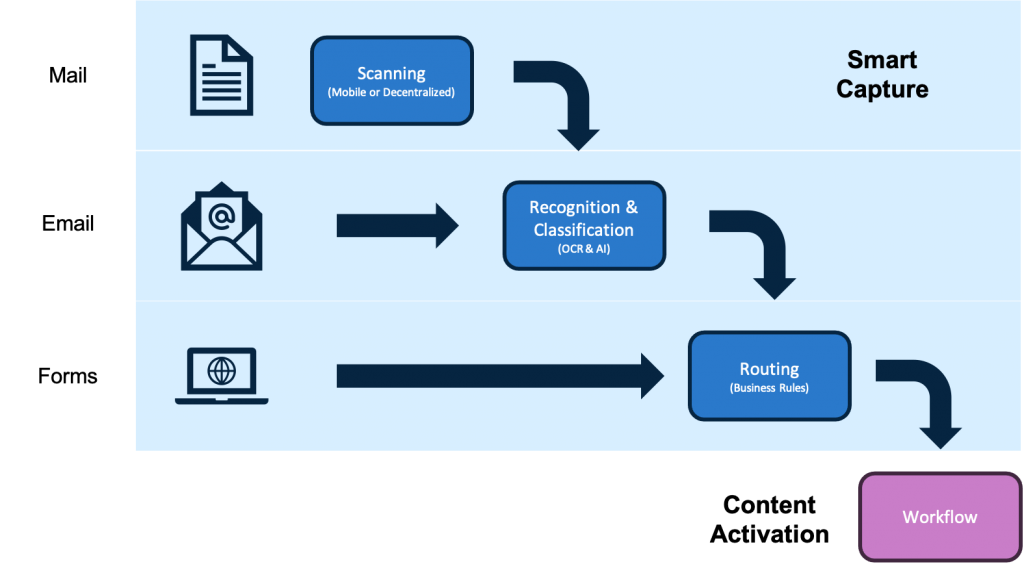As mentioned in my last post, using technology to transform the call center engagement model allows for a quick and efficient return on investment. To achieve this, there are 6 proven use cases. This particular post focuses on one of these use cases, the automation of mail or email requests to ensure more consistent processing and quality customer service.
Did you say mail?
I can already hear you say: “But no one wants to use paper mail anymore! Businesses should convert do everything electronically”. In fact, we are in the middle of a debate on this very subject at government services level in Quebec. However, I can tell you that it will be some time paper mail disappears completely. It is therefore important to think about how to integrate both mail and emails. The idea is quite simple: convert paper mail into an electronic and usable product. But how can it succeed?
There are several smart capture tools that allow you to convert mail into an electronic document and to read it. With today’s technologies, it is even possible to make a high-quality capture directly from your smartphone (personally, I use BOX Capture…but there exist dozens of other tools). The idea behind smart capture is to allow the paper document to be saved in an electronic format as closed as possible from the source of creation. The longer the document remains in paper format, the more expensive it will be to process after.

We deploy mobile capture tools for our clients that allow the user (employee or customer) to make a capture directly from home without having access an expensive scanner (a simple smart phone is enough). When this is not possible, we set up processes that involve scanning paper mail as soon as it enters the mailroom. The idea is to turn paper mail into an electronic document and to treat it the same way as an e-mail and some other unstructured electronic transmission.
Automate processing with AI
Once documents are in an electronic format (scanned mail, e-mail attachments, emails), then artificial intelligence can start working its magic.
First, AI can help you find the desired information in a document. Like a human, AI will look at the document, recognize its content, and determine what it is about in order to extract relevant information. You’ll tell me it’s pretty simple! Yes and no. Yes, because we use character recognition techniques (OCR) to achieve this. On the other hand, OCR is combined with more complex visual recognition techniques (smart document understanding) that will try to determine what is being read based both the positioning of the content on the page and the other information that surrounds what is being read. For example, if we see a date in the header of a letter, it is probably the date of the document. Similarly, if we see a number next to the word “total”, it is likely to be the total of an invoice.

When it is not possible to recognize the document, the AI can then read it in its entirety in order to understand what it is about. In this kind of project, we usually combine sentiment analysis (determining emotions expressed in a message) with natural language comprehension tools to recognize the intent of the document and the entities involved. This is similar to a chatbot with the exception that there is no conversation. It is a bit as if the document was a very long question that was being asked to a chatbot.
Recently, we’ve been using this kind of logic when analyzing incoming emails from our own customer service department. Thanks to this application, we are able to understand the intention of the customer who contacts us. We also enrich the data by giving the person to whom the email is sent a sentimental analysis that provides additional context for our employees.
Does it really work?
It is a legitimate question. Indeed, setting up this kind of system still requires a significant investment to define the business rules around automation. However, the technology required is not that expensive, especially if it is approached in a cloud-free form, because in that case, the costs are more operational than capitalized.
A few weeks ago, I was talking to IBM’s global team who, for this type of project—are responsible for major customers around the world, and we found that the gains we had calculated were similar to theirs. Thus, we found that this type of project has the following positive impacts:
– Reduction of the average support time for the project by 30 to 40%.
– Partial or complete automation of the processing requests in 50% range.
Now imagine a customer service center employing several hundred agents who also receive hundreds of calls per day. The gains quickly add up to hundreds of thousands of dollars!
More precisely, the payoffs normally start in the first few weeks after going live and usually become conclusive after 8 weeks. Furthermore, thanks to the garage approach, we are able to develop this type of application over only a few weeks and reach maturity after a period of 6 to 8 months.
Are you ready to innovate?
This type of project may seem complex, but it is often simpler than you think. With technologies such as IBM Watson and IBM Digital Business Automation and an agile approach, it is possible to deploy a minimum viable product for a few hundred thousand dollars…with an almost real-time return on investment!




